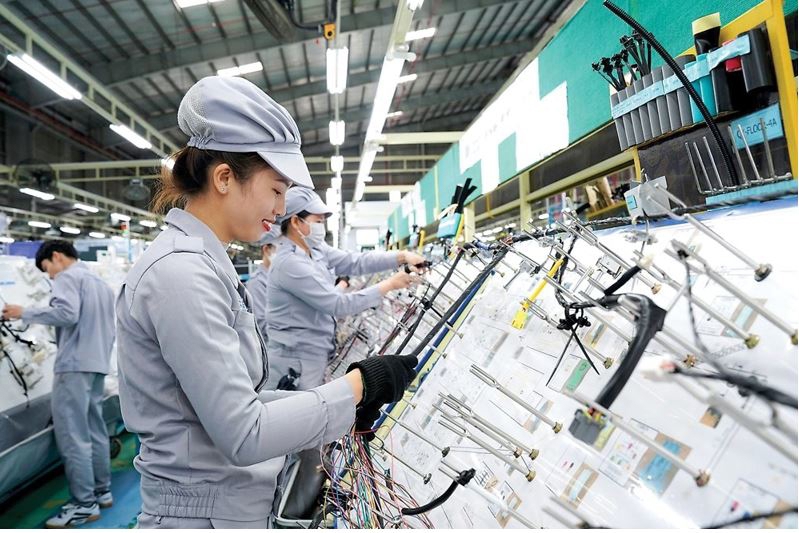Right policy vision crucial for growth
Vietnam’s target of high and sustainable growth to take it to the ranks of high-income countries demands the right policy vision from the outset.

Vietnam has set out an ambitious development roadmap, aiming for GDP growth of 8 per cent in 2025 and moving towards double-digit growth during the 2026-2030 period. Looking even further ahead, the country envisions joining the group of upper-middle-income economies by 2030 and ascending to the ranks of high-income nations by 2045. These are not merely growth estimates; they vividly reflect a strong aspiration to rise, showcasing a strategic vision, effective governance, and consistency in macro-economic policy management.
To realize these high and sustainable economic growth targets, Vietnam will need to adopt a development mindset that is flexible, innovative, and breakthrough-oriented.
Three scenarios
According to analysis by a research team from the National Economics University (NEU), there are three potential economic growth scenarios for Vietnam to 2045. Each represents a distinct development pathway, with varying levels of risk and corresponding policy requirements for the country to achieve high economic growth.
The first scenario - Scenario A - follows a “Fast Start” model, designed to generate a significant boost in the early stages to rapidly scale up the size and position of the national economy. Vietnam’s GDP is projected to grow at an average annual rate of 11 per cent from 2025 to 2029, then taper off to 9 per cent annually between 2030 and 2037, and finally stabilize at 7-8 per cent annually from 2038 to 2045. However, experts caution that this model carries the risk of overload in the initial years, which could lead to “burnout” if not supported by flexible adjustments and substantial resources.
The second scenario - Scenario B - adopts a “Prolonged Acceleration” model. This path maintains a high growth rate of 11 per cent annually for a longer period (2025-2031), then gradually decreases to 8.5-9 per cent (2032-2038) and 6.5-7.5 per cent (2039-2045). Economists note that this approach helps distribute growth pressure more evenly over time, allowing better policy and investment preparation. However, it faces the challenge of sustaining strong and stable growth momentum over an extended period.
The third scenario - Scenario C - follows a “Growth Wave” model. Vietnam’s economic growth is segmented into clearly defined “phases”: 2025-2030 is a preparatory phase, with growth of 8-10 per cent annually; 2031-2035 is an acceleration phase, reaching 11-12 per cent; followed by 8.5-9 per cent during 2036-2040; and, finally, 6.5-7.5 per cent from 2041-2045. Many experts consider this scenario the most feasible, as its growth pace aligns with natural development cycles and reduces the risk of “growth shocks”.
Notably, under Scenario C, Professor Tran Thi Van Hoa from the NEU believes the goals outlined are entirely achievable provided that Vietnam rigorously implements institutional reforms, comprehensively invests in strategic infrastructure, enhances workforce quality, and accelerates the application of advanced technologies across all economic sectors. If these conditions are fully met, Vietnam could reach per capita income of $28,370 by 2045, marking its transition into the group of high-income countries.
Strategic pathways
Vietnam achieving its ambitious economic growth targets will not be without challenges. In addition to internal issues such as workplace productivity, institutional quality, and business competitiveness, the country is also facing significant external pressures from global shifts, including geopolitical tensions, policy changes by major economies, global supply chain disruptions, and growing demands for green development, digital transformation, and energy security.
To navigate these challenges, Vietnam must adopt a development strategy that is both flexible and long-term. Relying on outdated growth models based on resource exploitation, cheap labor, and excessive public investment is no longer viable.
Professor Hoa argues that an economy aiming for high-income status must move away from traditional paths. The key lies in deep reforms to both institutions and development policies. Regarding institutions, it is essential to streamline organizational structures, ensure transparency in responsibilities, and enhance the legal framework to support the digital economy, innovation, and emerging business models. Flexible experimental mechanisms, such as industry-specific sandboxes, should also be implemented to suit local conditions.
Additionally, FDI needs to be more selective, focusing on high-tech sectors and ensuring technology transfer, workforce training, and partnerships with domestic enterprises to upgrade local value chains. Investing in digital infrastructure, particularly advanced technologies like AI, the Internet of Things (IoT), and big data, should be a strategic priority to drive breakthroughs in productivity and efficiency. “These are the core factors that will help Vietnam break through, not only in growth speed but also in the quality and sustainability of long-term development,” Professor Hoa said.
Dr. Dang Thi Thu Hoai, from the Institute for Policy and Strategy Studies, believes that although innovation has contributed to Vietnam’s economy in recent years, its overall effectiveness is still not clearly visible. To improve the quality of its growth, Vietnam needs to implement a synchronized set of key solutions. The first focus should be on boosting productivity in the private sector, which plays a central role in the economy. The second focus should be improving intra-sector productivity. Lastly, enhancing regional connectivity and investing in infrastructure are fundamental. “Investing in infrastructure and reorganizing provincial administrative units will optimize resource allocation and create a more efficient, sustainable growth model,” Dr. Hoai said.
Investment focus on key areas
Adding another perspective on policies for achieving high and sustainable economic growth in the years ahead, Dr. Nguyen Bich Lam, former Director General of the General Statistics Office (now the National Statistics Office at the Ministry of Finance), emphasized that effectively utilizing public investment resources is crucial for the economy’s recovery and long-term development.
While accelerating public investment in infrastructure is essential, this alone is not enough to ensure sustained growth. Without close integration with policies that support production and enhance domestic business capacity, public investment’s spillover effects will be limited, and maintaining high growth will be challenging.
Moreover, if public investment is scattered and lacks strategic focus, its effectiveness will be low, leading to wasted resources. Dr. Lam believes Vietnam must prioritize areas such as integrated logistics infrastructure, digital transformation in both the public and private sectors, clean energy development, and the growth of manufacturing. These are key for public investment to drive sustainable growth in the years ahead.
Improving workplace productivity is critical for long-term growth, but relying solely on human labor is insufficient.
Associate Professor Pham The Anh from the NEU suggested that Vietnam could learn from the successful strategies of rapidly-developing economies like Japan, South Korea, Singapore, and China. These countries focused on key industries, supported by strong policies in taxation, credit, and business reforms.
Additionally, these nations have a flexible approach to macro-economic management, effectively controlling inflation, maintaining fiscal discipline, stabilizing exchange rates, and restructuring their economies to adapt to global shifts. They also attract FDI to promote industrialization and expand exports. Infrastructure investment remains a foundation for long-term competitive advantage. “Vietnam can apply these international lessons by creating a structured industrial development strategy, focusing on key sectors, and ensuring a consistent and cohesive policy system,” Associate Professor Anh concluded. “This will be key to breaking through in growth, achieving high rates while ensuring quality and sustainability in the future.”
“Strengthening public investment in infrastructure is the right move, but it’s not enough. Without accompanying investments in production development and support for businesses, sustaining growth momentum will be difficult.”
Dr. Nguyen Bich Lam, former Director General of the General Statistics Office (now the National Statistics Office at the Ministry of Finance)
“An economy aiming for high-income status must move away from traditional paths. The key lies in deep reforms to both institutions and development policies.”
Professor Tran Thi Van Hoa from the National Economics University (NEU)







